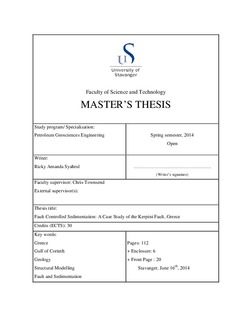| dc.contributor.author | Syahrul, Rizky Amanda | |
| dc.date.accessioned | 2014-10-23T08:58:42Z | |
| dc.date.available | 2014-10-23T08:58:42Z | |
| dc.date.issued | 2014-06-16 | |
| dc.identifier.uri | http://hdl.handle.net/11250/224382 | |
| dc.description | Master's thesis in Petroleum engineering | nb_NO |
| dc.description.abstract | The study area is located in Gulf of Corinth, Central Grecee. The focus of the study is located in the Kerpini area. The objective of this study is to learn about fault controlled sedimentation which is related to their internal structures including sedimentary layers and facies distribution of sediments within the Kerpini Fault Block.
It has been previously proposed, based on the field observations that sedimentation occurred during faulting and that the main direction of deposition is perpendicular to the fault strike (Ford et al., 2013). However, dip of the sedimentary rocks seem to have consistent values within the half grabens which is in contrast with classical syn-sedimentary models where dips of younger rocks are lower than the older rocks as the fault increases displacement.
According to the field work observations, apart from the basement (unit 2), there are 3 syn-fault deposits package that can be distinguished in the Kerpini Fault Block: 1) Massive Conglomerate (unit 2), 2) Early Sandstone-Conglomerate (Unit 3), and 3) Late Sandstone-Conglomerate (Unit 4). Dips of the unit 2 and 3 of sedimentary rocks are almost constant with an average of 20o-25o. The general dip directions (southeast) appear to be not directly perpendicular to the fault plane, but slightly oriented towards the maximum throw of the fault. Unit four has different bedding orientation (dipping north) and dips of the sedimentary rocks seem to have a gentler angle (some of them are almost horizontal) suggesting less influence of the fault movement. The sedimentation direction has been interpreted to have been sourced diagonal from both tips of the fault in the SW and SE as smaller grain sizes in the centre of the fault block are mapped. For the youngest sedimentary rocks (unit 4), the source has been interpreted coming from the E-W direction rivers.
A Number of modelling scenarios have been done and are suggesting the relationship between fault and sedimentation (sedimentary layers). Reverse drag would be an important factor to control the dip angles of sediments in syn-fault deposits. In addition to that, the fault evolution and its movement for each phase are important to control the sedimentary layers and sediments distribution, because it will bring an effect to the evolution of accommodation space. Although lack of decreasing dip angle of sediments towards the younger sediments can be explained by the distance of reverse drag which might be far away from the fault. It is still having slightly changes in dip angles (not completely consistent); therefore, another possibility has been proposed to explain this feature. Episodic movement of the fault is another possible answer to explain the consistent dip angles within the Kerpini Fault Block besides the classical and reverse drag controlled in syn-fault deposits configuration.
Grain size and clast components analysis in the sedimentary rocks within Kerpini Fault Block were used to compose the paleo-drainage map in the fault block. Most of the source sediments have been interpreted as coming from the south through the Vouraikos and Kerinitis River. There are smaller source sediments coming from the north due to the foot-wall uplift of the Dhoumena Fault Block. It has been interpreted that way to explain the grain size anomaly in the central part of the Kerpini Fault Block where several outcrops show bigger grains composition although it should be smaller if they follow the trend of the grain size in Kerpini Fault Block (fining to the N and WNW). | nb_NO |
| dc.language.iso | eng | nb_NO |
| dc.publisher | University of Stavanger, Norway | nb_NO |
| dc.relation.ispartofseries | Masteroppgave/UIS-TN-IPT/2014; | |
| dc.subject | petroleumsteknologi | nb_NO |
| dc.subject | petroleumsgeologi | nb_NO |
| dc.subject | Greece | nb_NO |
| dc.subject | Gulf of Corinth | nb_NO |
| dc.subject | Hellas | nb_NO |
| dc.subject | geology | nb_NO |
| dc.subject | structural modelling | nb_NO |
| dc.subject | fault and sedimentation | nb_NO |
| dc.subject | Kerpini fault | nb_NO |
| dc.subject | sedimentation | nb_NO |
| dc.title | Fault controlled sedimentation: A case study of the Kerpini fault, Greece | nb_NO |
| dc.type | Master thesis | nb_NO |
| dc.subject.nsi | VDP::Technology: 500::Rock and petroleum disciplines: 510::Geological engineering: 513 | nb_NO |
